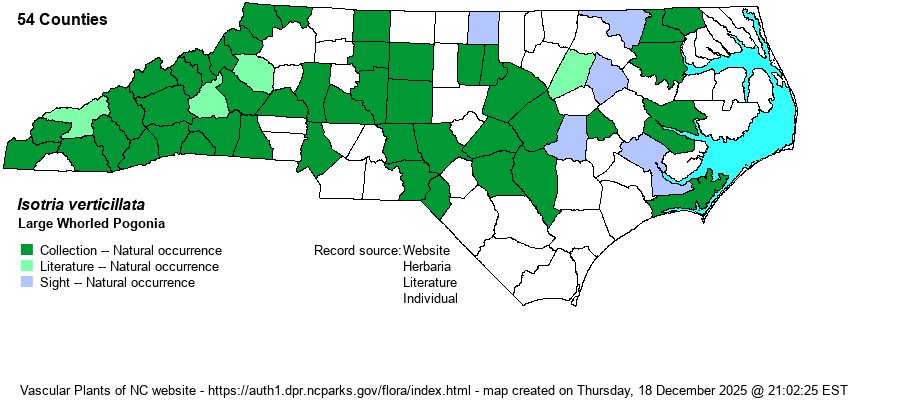| Author | (Muhlenberg ex Willdenow) Rafinesque | |
| Distribution | Scattered over the Mountains, Piedmont, and northern two-thirds of the Coastal Plain. Likely absent in the far eastern counties (no records east of Gates, Beaufort, and Carteret counties) and probably also in the far southeastern counties. Scarce in the Sandhills proper, being found mostly near brownwater rivers that run through the region.
This is an Eastern species ranging from ME and MI south to the FL panhandle and eastern TX. It is very scarce in the South Atlantic Coastal Plain. | |
| Abundance | Rare to uncommon in the Mountains and Piedmont, and declining as well, likely owing to deer browse and perhaps to fire suppression. Very rare to rare, and probably declining, in the Coastal Plain. Despite it having been recorded from more than 50 counties, this is a difficult species to find nowadays. As a result, in the past few years the NC NHP has placed the species on its Watch List. | |
| Habitat | This species grows in a moderate variety of acidic upland forests, typically in fairly dry to mesic to moist soils. It usually grows where there are some ericads in the shrub layer, such as various Vaccinium or Gaylussacia species. It grows in somewhat more mesic sites in the mountains than farther east, and it can grow close to stream banks in some areas. | |
| Phenology | Blooms from April to July, but often in late April or May -- earlier by a month or more than the similar I. medeoloides. It fruits a few weeks after flowering. | |
| Identification | This is an odd yet beautiful spring-blooming wildflower that, sadly, is becoming more difficult to find each year. It has a single purplish to greenish stem that grows to about 9-12 inches tall, with a whorl of usually five elliptical and entire leaves at the top; the leaves average about 2.5 inches long and are a dark green, generally without the glaucescent look of leaves of I. medeoloides. At the summit grows a single large flower, which has three long and narrow sepals that are green and purple; they can reach 2-3 inches long. The yellow-green petals can be about 1 inch long and form a tube, with a white lip that is spotted with purple. Thus, from one sepal tip to another, the flower can be at least 4 inches across. The much more common Medeola virginiana has a stem that also can be purple but it is a thinner and more solid stem; it has typically about seven bright green leaves in a whorl, and when in bloom has small flowers above a second set of whorled leaves. | |
| Taxonomic Comments | None
| |
| Other Common Name(s) | Whorled Pogonia, Large Five-leaves | |
| State Rank | S2S3 | |
| Global Rank | G5 | |
| State Status | W1 | |
| US Status | | |
| USACE-agcp | FACU link |
| USACE-emp | FACU link |

